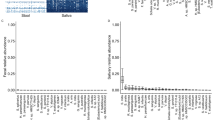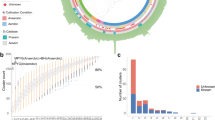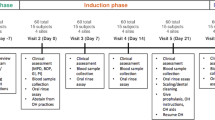Abstract
The composition of the oral microbiota from 10 individuals with healthy oral tissues was determined using culture-independent techniques. From each individual, 26 specimens, each from different oral sites at a single point in time, were collected and pooled. An 11th pool was constructed using portions of the subgingival specimens from all 10 individuals. The 16S ribosomal RNA gene was amplified using broad-range bacterial primers, and clone libraries from the individual and subgingival pools were constructed. From a total of 11 368 high-quality, nonchimeric, near full-length sequences, 247 species-level phylotypes (using a 99% sequence identity threshold) and 9 bacterial phyla were identified. At least 15 bacterial genera were conserved among all 10 individuals, with significant interindividual differences at the species and strain level. Comparisons of these oral bacterial sequences with near full-length sequences found previously in the large intestines and feces of other healthy individuals suggest that the mouth and intestinal tract harbor distinct sets of bacteria. Co-occurrence analysis showed significant segregation of taxa when community membership was examined at the level of genus, but not at the level of species, suggesting that ecologically significant, competitive interactions are more apparent at a broader taxonomic level than species. This study is one of the more comprehensive, high-resolution analyses of bacterial diversity within the healthy human mouth to date, and highlights the value of tools from macroecology for enhancing our understanding of bacterial ecology in human health.
Similar content being viewed by others
Log in or create a free account to read this content
Gain free access to this article, as well as selected content from this journal and more on nature.com
or
References
Aas JA, Paster BJ, Stokes LN, Olsen I, Dewhirst FE . (2005). Defining the normal bacterial flora of the oral cavity. J Clin Microbiol 43: 5721–5732.
Chao A, Chazdon RL, Colwell RK, Shen T-J . (2005). A new statistical approach for assessing compositional similarity based on incidence and abundance data. Ecol Lett 8: 148–159.
Cogen AL, Nizet V, Gallo RL . (2008). Skin microbiota: a source of disease or defence? Br J Dermatol 158: 442–455.
Colwell RK . (2005). EstimateS: Statistical Estimation of Species Richness and Shared Species from Specimens. Version 7. User's Guide and application published at:http://purl.oclc.org/estimates.
Costello EK, Lauber CL, Hamady M, Fierer N, Gordon JI, Knight R . (2009). Bacterial community variation in human body habitats across space and time. Science 326: 1694–1697.
DeSantis TZ, Hugenholtz P, Larsen N, Rojas M, Brodie EL, Keller K et al. (2006). Greengenes, a chimera-checked 16S rRNA gene database and workbench compatible with ARB. Appl Environ Microbiol 72: 5069–5072.
Dethlefsen L, Eckburg PB, Bik EM, Relman DA . (2006). Assembly of the human intestinal microbiota. Trends Ecol Evol 21: 517–523.
Dethlefsen L, Huse S, Sogin ML, Relman DA . (2008). The pervasive effects of an antibiotic on the human gut microbiota, as revealed by deep 16S rRNA sequencing. PLoS Biol 6: e280.
Dethlefsen L, McFall-Ngai M, Relman DA . (2007). An ecological and evolutionary perspective on human-microbe mutualism and disease. Nature 449: 811–818.
Dewhirst FE, Izard J, Paster BJ, Tanner AC, Wade WG, Yu W-H et al. (2008). The Human Oral Microbiome Database. http://www.HOMD.org.
Diaz PI, Chalmers NI, Rickard AH, Kong C, Milburn CL, Palmer Jr RJ et al. (2006). Molecular characterization of subject-specific oral microflora during initial colonization of enamel. Appl Environ Microbiol 72: 2837–2848.
Eckburg PB, Bik EM, Bernstein CN, Purdom E, Dethlefsen L, Sargent M et al. (2005). Diversity of the human intestinal microbial flora. Science 308: 1635–1638.
Edwards U, Rogall T, Blocker H, Emde M, Bottger EC . (1989). Isolation and direct complete nucleotide determination of entire genes. Characterization of a gene coding for 16S ribosomal RNA. Nucleic Acids Res 17: 7843–7853.
Flint HJ, Duncan SH, Scott KP, Louis P . (2007). Interactions and competition within the microbial community of the human colon: links between diet and health. Environ Microbiol 9: 1101–1111.
Good IJ . (1953). The population frequencies of species and the estimation of population parameters. Biometrika 40: 237–264.
Gotelli NJ, Entsminger GL . (2004). EcoSim: Null Models Software for Ecology Version 7. Acquired Intelligence Inc. & Kesey-Bear. Jericho, VT 05465. http://garyentsminger.com/ecosim/index.htm.
Haffajee AD, Socransky SS, Patel MR, Song X . (2008). Microbial complexes in supragingival plaque. Oral Microbiol Immunol 23: 196–205.
Horner-Devine MC, Silver JM, Leibold MA, Bohannan BJ, Colwell RK, Fuhrman JA et al. (2007). A comparison of taxon co-occurrence patterns for macro- and microorganisms. Ecology 88: 1345–1353.
Hugenholtz P . (2002). Exploring prokaryotic diversity in the genomic era. Genome Biol 3: reviews0003.1–0003.8.
Huse SM, Dethlefsen L, Huber JA, Welch DM, Relman DA, Sogin ML . (2008). Exploring microbial diversity and taxonomy using SSU rRNA hypervariable tag sequencing. PLoS Genet 4: e1000255.
Kazor CE, Mitchell PM, Lee AM, Stokes LN, Loesche WJ, Dewhirst FE et al. (2003). Diversity of bacterial populations on the tongue dorsa of patients with halitosis and healthy patients. J Clin Microbiol 41: 558–563.
Keijser BJ, Zaura E, Huse SM, van der Vossen JM, Schuren FH, Montijn RC et al. (2008). Pyrosequencing analysis of the oral microflora of healthy adults. J Dent Res 87: 1016–1020.
Kreth J, Merritt J, Shi W, Qi F . (2005). Competition and coexistence between Streptococcus mutans and Streptococcus sanguinis in the dental biofilm. J Bacteriol 187: 7193–7203.
Kroes I, Lepp PW, Relman DA . (1999). Bacterial diversity within the human subgingival crevice. Proc Natl Acad Sci USA 96: 14547–14552.
Kumar PS, Griffen AL, Moeschberger ML, Leys EJ . (2005). Identification of candidate periodontal pathogens and beneficial species by quantitative 16S clonal analysis. J Clin Microbiol 43: 3944–3955.
Lane DJ, Pace B, Olsen GJ, Stahl DA, Sogin ML, Pace NR . (1985). Rapid determination of 16S ribosomal RNA sequences for phylogenetic analyses. Proc Natl Acad Sci USA 82: 6955–6959.
Lepp PW, Brinig MM, Ouverney CC, Palm K, Armitage GC, Relman DA . (2004). Methanogenic Archaea and human periodontal disease. Proc Natl Acad Sci USA 101: 6176–6181.
Leser TD, Amenuvor JZ, Jensen TK, Lindecrona RH, Boye M, Moller K . (2002). Culture-independent analysis of gut bacteria: the pig gastrointestinal tract microbiota revisited. Appl Environ Microbiol 68: 673–690.
Ley RE, Peterson DA, Gordon JI . (2006). Ecological and evolutionary forces shaping microbial diversity in the human intestine. Cell 124: 837–848.
Lozupone C, Hamady M, Knight R . (2006). UniFrac—an online tool for comparing microbial community diversity in a phylogenetic context. BMC Bioinformatics 7: 371.
Ludwig W, Strunk O, Westram R, Richter L, Meier H, Yadhukumar et al. (2004). ARB: a software environment for sequence data. Nucleic Acids Res 32: 1363–1371.
Nasidze I, Li J, Quinque D, Tang K, Stoneking M . (2009). Global diversity in the human salivary microbiome. Genome Res 19: 636–643.
Palmer C, Bik EM, Digiulio DB, Relman DA, Brown PO . (2007). Development of the human infant intestinal microbiota. PLoS Biol 5: e177.
Paster BJ, Boches SK, Galvin JL, Ericson RE, Lau CN, Levanos VA et al. (2001). Bacterial diversity in human subgingival plaque. J Bacteriol 183: 3770–3783.
Schloss PD, Handelsman J . (2004). Status of the microbial census. Microbiol Mol Biol Rev 68: 686–691.
Schloss PD, Handelsman J . (2005). Introducing DOTUR, a computer program for defining operational taxonomic units and estimating species richness. Appl Environ Microbiol 71: 1501–1506.
Schloss PD, Westcott SL, Ryabin T, Hall JR, Hartmann M, Hollister EB et al. (2009). Introducing mothur: open source, platform-independent, community-supported software for describing and comparing microbial communities. Appl Environ Microbiol 75: 7537–7541.
Socransky SS . (1963). The microbiota of the gingival crevice area of man. I. Total microscopic and viable counts and counts of specific organisms. Arch Oral Biol 8: 275–280.
Socransky SS, Haffajee AD, Cugini MA, Smith C, Kent Jr RL . (1998). Microbial complexes in subgingival plaque. J Clin Periodontol 25: 134–144.
Stone L, Roberts A . (1990). The checkerboard score and species distributions. Oecologia 85: 74–79.
Tappenden KA, Deutsch AS . (2007). The physiological relevance of the intestinal microbiota–contributions to human health. J Am Coll Nutr 26: 679S–683S.
Woese CR, Fox GE . (1977). Phylogenetic structure of the prokaryotic domain: the primary kingdoms. Proc Natl Acad Sci USA 74: 5088–5090.
Ximenez-Fyvie LA, Haffajee AD, Socransky SS . (2000). Comparison of the microbiota of supra- and subgingival plaque in health and periodontitis. J Clin Periodontol 27: 648–657.
Zaura E, Keijser BJ, Huse SM, Crielaard W . (2009). Defining the healthy ‘core microbiome’ of oral microbial communities. BMC Microbiol 9: 259.
Acknowledgements
We thank Karla Lightfield for technical assistance and Katie Shelef for help with pooling and extracting the oral specimens. This work was funded by NIH R01-DE014868 (CFL), NIH R01-DE13541 (DAR) and NIH Pioneer Award DP1-OD000964 (DAR). DAR is supported by the Thomas C and Joan M Merigan Endowment at Stanford University.
Author information
Authors and Affiliations
Corresponding author
Additional information
Supplementary Information accompanies the paper on The ISME Journal website
Rights and permissions
About this article
Cite this article
Bik, E., Long, C., Armitage, G. et al. Bacterial diversity in the oral cavity of 10 healthy individuals. ISME J 4, 962–974 (2010). https://doi.org/10.1038/ismej.2010.30
Received:
Revised:
Accepted:
Published:
Issue date:
DOI: https://doi.org/10.1038/ismej.2010.30
Keywords
This article is cited by
-
Detection of viable oral bacteria of the patient on the surgical mask of dentists
BDJ Open (2024)
-
Bacterial contamination potential of personal protective equipment itself in dental aerosol-producing treatments
Odontology (2024)
-
History of dental biomaterials: biocompatibility, durability and still open challenges
Heritage Science (2023)
-
The oral microbiota is a reservoir for antimicrobial resistance: resistome and phenotypic resistance characteristics of oral biofilm in health, caries, and periodontitis
Annals of Clinical Microbiology and Antimicrobials (2023)
-
Environmental influences on Streptococcus sanguinis membrane vesicle biogenesis
The ISME Journal (2023)



